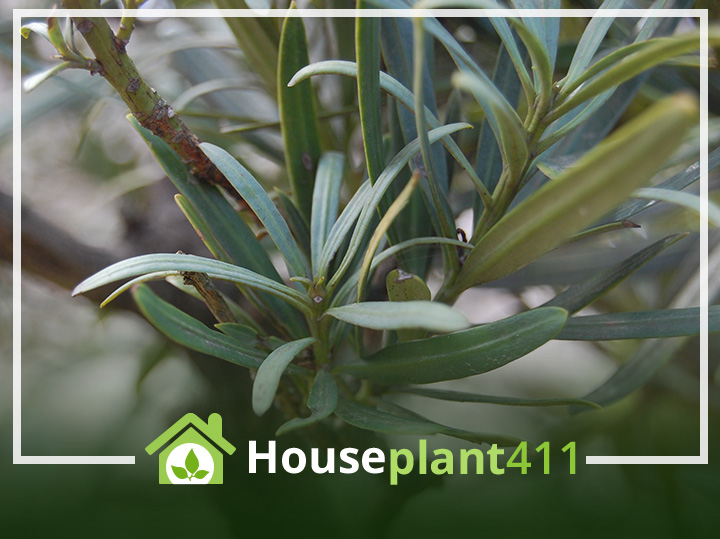A Podocarpus plant, also called a Buddhist Pine or Japanese Yew, is a very dense, upright, slow growing evergreen that originally came from China and Japan. It has long slender dark green leathery leaves. A Podocarpus plant grows straight up with very little side branching unless it is actively pruned. This plant is relatively simple to care for and adapts well to various conditions. It is easily trained to be a bonsai or a topiary. These plants are considered poisonous and should be kept away from pets and children. Read more about common houseplants that are poisonous in Don’t Feed Me to Your Cat: A Guide to Poisonous Houseplants. When planted outside in the ground a Podocarpus plant grows quite large, but when used indoors or on the porch as a potted plant, it remains a small tree or shrub.
Plant Care
Light
A Podocarpus requires very bright indirect light. If it is not getting enough light the lower needles on the branches become large and elongated.
Water
Keep the soil moist but not soggy; allow the top two inches to dry out before watering. Brown leaf tips or gray needles indicate over- watering.
Fertilizer
Feed a Podocarpus every two weeks in the spring and summer when it is actively growing. Use a plant food that is designed for acid loving plants such as Miracid at 1/2 the recommended strength.
Temperature
Podocarpus prefer cool temperatures between 50°-75°F (10°-23.9°C).
Humidity
These plants do best in medium humidity. If your home is very dry, especially in the winter, set a small humidifier near your Podocarpus or place it on a bed of wet gravel. Be sure the plant is sitting on the gravel and not in the water.
Flowering
The flowers of this plant are very small and inconspicuous.
Pests
Podocarpus are susceptible to Mealy Bugs and Scale.
Diseases
Although the soil should be kept somewhat moist, over watering leads to root rot. Sooty Mold is another disease that can infect a Podocarpus.
Soil
Use a well-aerated acidic soil. Add perlite or sand if your soil seems too heavy or clay-like.
Pruning
A Podocarpus must be actively and aggressively pruned to maintain any kind of shape. Pruning back the new growth on the vertical stem encourages side branches and a fuller bushier plant.
Propagation
Propagate a Podocarpus using soft wood stem cuttings in the early spring.
Poisonous Plant Info
A Podocarpus has a level #1 toxicity if eaten. However, various parts of the plant, especially the seeds within the berries are very harmful to dogs, cats, and horses. This plant should be kept away from small children and animals.
FAQ
First stake the main vertical stem of your Podocarpus; next prune back the new growth on the vertical stem. Cutting off the new growth encourages side branches. Your Podocarpus will become sturdier and bushier in no time.
The main reason a Podocarpus gets brown tips is from over-watering. Cold drafts and very dry air can also cause brown tips.
The Black Dust is called sooty mold. sooty molds are a form of fungi that grow on the sugary honeydew secreted by Aphids, scales, the whitefly, and other insects that suck the sap from plants. sooty mold is an unsightly black powder that can quickly coat the leaves of a plant in just a few weeks. The fungus itself doesn’t really harm the plant; it just ruins the plant’s appearance. What you need to do is get rid of the insects that are secreting the honeydew that is attracting the sooty mold.

